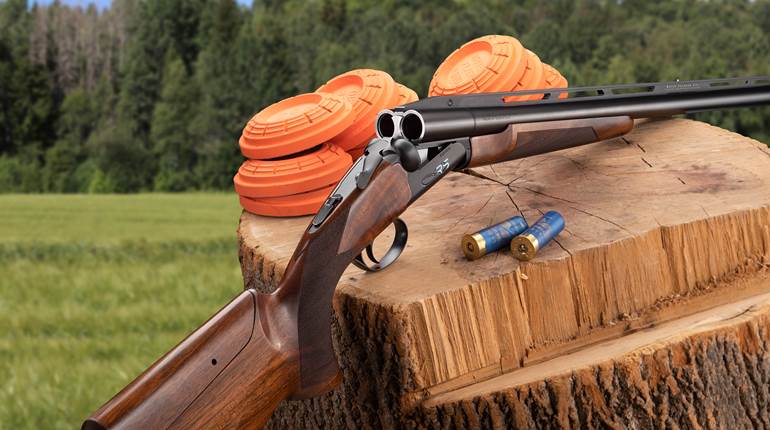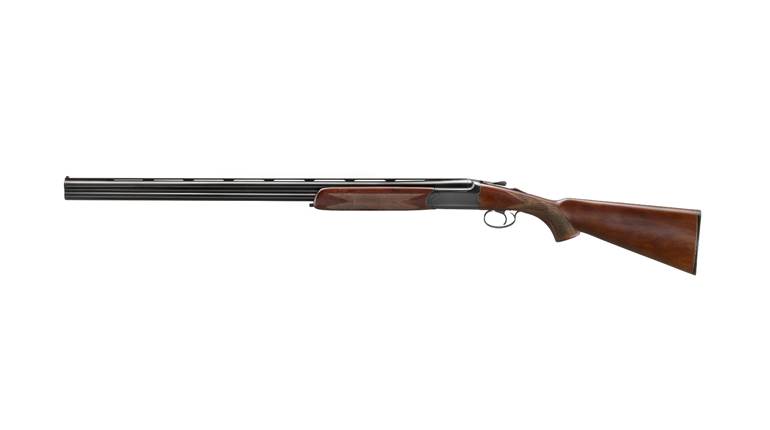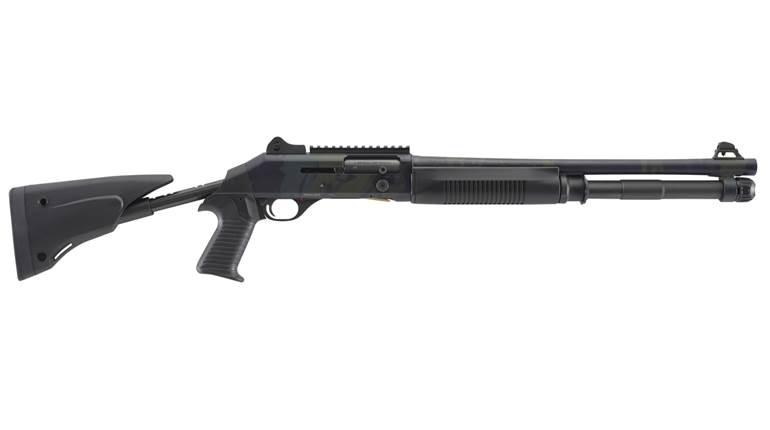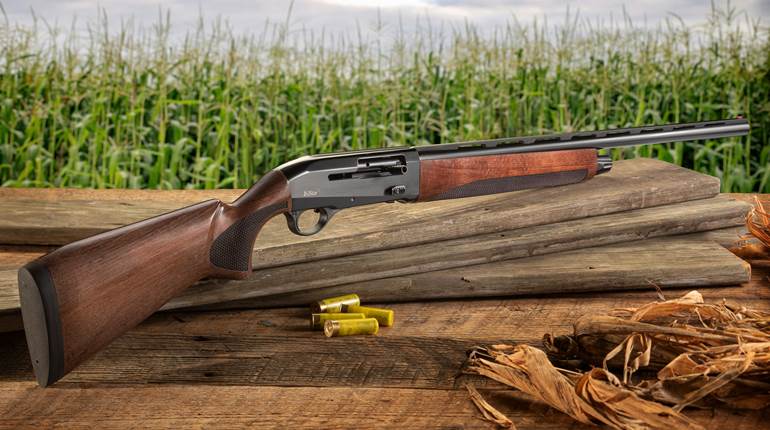
In 1903, two ground-breaking semi-automatic shotguns were introduced: John Browning’s famous Browning Automatic 5 and the little-known Normal by Danish gunsmith Christian Sjörgren. Browning’s worked on a long-recoil design, whereas Sjörgren’s operated on the principal of inertia. More than a century later, in 2012, the two designs have been merged into Browning’s new A5, which blends the styling of the Automatic 5’s square, humped back with the Normal’s operating system.
The original Auto 5’s bolt and barrel were locked together and pushed completely to the back of the receiver by recoil forces, causing the characteristic “ping” as the assembly struck the rear of the receiver. The Sjörgren Normal’s bolt was backed by a massive block. When the gun fired, the block remained stationary, tightening the engagement of the locking lugs. Once the shot cleared the barrel, the recoil was stopped by the shooter’s shoulder and, at that point, the weight moved rearward, unlocking the lugs, ejecting the fired shell then driving a fresh round into the chamber as the bolt moved forward.
The inertia system-Browning calls it “Kinematic”-has two real advantages: It is very clean; and inertia systems, with few moving parts, are highly reliable. The one disadvantage of the inertia system is lack of recoil attenuation, hence other manufacturing methods are used to attenuate the felt recoil.
Our test A5 is Browning’s newest that is chambered for, and the action adjusted to fire, 12-gauge, 3½-inch ammunition plus 2¾ inch and 3-inch rounds. The first generation of new A5s was made only in a 3-inch chamber, making the new gun a line extension of an already successful product.
Out of the box, we noted the release just forward of the trigger guard. Pulled rearward, it allows the two-piece carrier to drop, and enables the bolt to be locked to the rear. The fore-end comes with a yellow ring at its forward end that is to prevent potential damage in shipping. Once removed, the fore-end is slipped over the barrel ring, and then, using light pressure, the rear of the fore-end is snapped into place over the breech-end of the barrel. Once together, the barrel/fore-end assembly can slide over magazine tube, and into engagement with the receiver. The magazine cap is the traditional screw-on style, and, once tightened, makes the A5 ready to shoot.
The owner’s manual is very explicit in regard to disassembly for cleaning. Briefly, the  charging handle is pulled out of the bolt, and, after removing the barrel/fore-end, the bolt assembly is then removed through the front of the receiver. Using the cross-T of the choke-tube wrench or proper drift punch, the pins holding the trigger group are pushed out, and the assembly removed. Reassembly is in the reverse order, with the link at the rear of the bolt assembly contacting the bolt-return-spring follower. That is done by holding the receiver vertically and coaxing the link to drop into the follower’s pocket by jiggling it if necessary.
charging handle is pulled out of the bolt, and, after removing the barrel/fore-end, the bolt assembly is then removed through the front of the receiver. Using the cross-T of the choke-tube wrench or proper drift punch, the pins holding the trigger group are pushed out, and the assembly removed. Reassembly is in the reverse order, with the link at the rear of the bolt assembly contacting the bolt-return-spring follower. That is done by holding the receiver vertically and coaxing the link to drop into the follower’s pocket by jiggling it if necessary.
Designed as a waterfowl and turkey gun, the test gun had a dipped camouflage finish of Mossy Oak Duck Blind-other patterns are available, as is a matte-black version. Such finishes serve to both help conceal the A5 and protect it against corrosion. The buttstock and magazine cap have sling swivel studs for easy carrying. Probably most important is the enclosed shim kit and stock-lengthening spacers for customizing fit.
We referenced recoil attenuation, and Browning's solution is its high-tech Inflex II recoil pad. The pad both softens rearward motion and upward recoil into the shooter’s cheek. While shooting patterns and chronographing the test loads, we found that while recoil wasn’t mild with 11⁄8-ounces, 3-inch Kent Fasteel, at an average of 1571 f.p.s., it was quite acceptable.
With the synthetic stock and fore-end, the A5 weighs 6 pounds, 13 ounces, and at that  weight recoil with 3½-inch ammunition will be severe; 3½-inch shells with a 3-foot velocity of 1625 f.p.s. and 1¼-ounce of shot packs of recoil energy of 25.1 feet-pounds and has a recoil velocity 66.9 feet-seconds, about the equivalent of shooting a large-caliber rifle.
weight recoil with 3½-inch ammunition will be severe; 3½-inch shells with a 3-foot velocity of 1625 f.p.s. and 1¼-ounce of shot packs of recoil energy of 25.1 feet-pounds and has a recoil velocity 66.9 feet-seconds, about the equivalent of shooting a large-caliber rifle.
The barrel is overbored to 0.740 inches as compared to the nominal 0.725 inches. In testing going back to that of The American Rifleman’s late technical editor Capt. Charles Askins, who in the summer of 1920 extensively tested shotgun barrels with the ammunition of the day, it was found that overboring barrels to 0.740 inches produced the most even and dense patterns, particularly with large pellets such as BB, No. 2 and No. 4, which are the choices of waterfowl hunters. Testing with today’s more sophisticated ammunition still supports Askins' findings nearly a century later.
Topping the A5’s barrel are Browning’s Invector DS choke tubes. Three were shipped with the A5, labeled improved cylinder, modified and full. When checked against the internal bore diameter of 0.7415 inches, they measured I.C. 0.010 inches, Mod. 0.020 inches and Full (turkey) 0.050 inches. The newer Browning choke tubes are constructed with an expanding brass ring at the bottom that is longitudinally slit and intended to stop the remains of propellant combustion from infiltrating between the skirt of the choke tube and barrel wall. In testing, we found little evidence of accumulated dirt.
Patterns shot with 11⁄8-ounce Kent Fasteel at an average chronographed velocity of 1571 f.p.s. using the 0.020-inch constriction choke tube labeled “Modified lead," “Full steel" produced patterns averaging 75 percent of the load of 80 BB-size steel pellets within the 30-inch circle; solid full-choke performance. The patterns showed some central thickening with the inner 21-inch circle averaging 36 pellet strikes, or 45 percent and the outer 30-inch ring having 24 average pellet strikes or 30 percent. Not a bad distribution for very large shot.
We took the A5 on a waterfowl hunt with Blue Sky Outfitters in the Peace River area of Alberta. There, the “speed load” feature, a carry-over from the Auto 5, was especially useful for fast reloading. Handling wise, one couldn’t ask for more. The A5 seemed like a bodily extension that followed our eyes and produced many memorable shots.
Outside of waterfowl, turkey and, to an extent, deer hunting, there’s little reason to use 3½-inch 12-gauge shotshells; however, the extra shot and velocity of these lengthened loads offer a slight improvement in external and terminal ballistics. The new Browning A5 3½ inch is capable of harnessing that extra performance when so desired.
Importer: Browning Arms Co., One Browning Place, Morgan, UT 84050: (801) 876-2711
Action type: inertia-operated, semi-automatic shotgun
Gauge: 12, 3½" (also 2¾" and 3")
Receiver: aluminum alloy
Trigger: single-stage; 6-lb., 10-oz. pull
Magazine: tubular; four- (2¾"), three- (3" or 3½") round capacity
Barrel: 26", 28" (tested) or 30"; overbored to 0.7415" (test gun) with screw-in choke tubes
Sights: ventilated rib with red, translucent interchangeable front beads
Stock: synthetic coated with dipped Mossy Oak Duck Blind camouflage: length of pull, 14¼"; drop at comb, 1¼"; drop at heel, 21⁄8"
Overall Length: 475⁄8", 495⁄8" (tested), 515⁄8"
Weight: 6 lbs., 13 ozs.
Metal Finish: Mossy Oak Duck Blind (tested), Realtree Max 4, black
Accessories: three Invector DS choke tubes with wrench, shim kit and spacers for stock adjustment, safety lock, owner’s manual
Suggested retail price: $1,500-$1,700





































